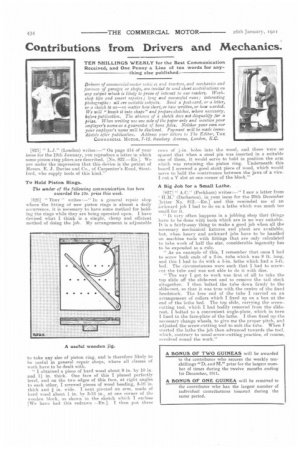Contributions from Drivers and Mechanics:
Page 18

If you've noticed an error in this article please click here to report it so we can fix it.
TEN SHILLINGS WEEKLY for the Best Communication Received, and One Penny a Line of ten words for any thing else published.
Drivers of commercial-motor vehices and tractors, and mechanics and foremen of garages or shops, are invited to send short contributions on any subject which is likely to prove of interest to our readers. Workshop tips and smart repairs ; long and successful runs; interesting photographs : all are suitable subjects. Send a post-card, or a letter, or a sketch to us—no matter how short, or how written, or how worded. We will "knock it into shape" and prepare sketches, where necessary, before publication. The absence of a sketch does not disqualify for a prize. When writing use one side of the paper only and mention your employer's name as a guarantee of bona fides. Neither your own nor your employer's name will be disclosed. Payment will be made immediately after publication. Address your letters to The Editor, THE COMMERCIAL MOTOR, 7-15, Rosebery Avenue, London, E.C.
[825] " L.J." (London) writes:—" On page 414 of your issue for the 19th January, you reproduce a letter in which some piston-ring pliers are described. [No. 822.—En.]. We are under the impression that this device is the patent of Messrs. E. J. Davies and Co., of Carpenter's Road, Stratford, who supply tools of this kind."
To Hold Piston Rings.
The sender of the following communication has been awarded the 10s. prize this week.
[826] " ToRY " writes:—" In a general repair shop where the fitting of new piston rings is almost a daily occurrence, it is necessary to have some method for holding the rings while they are being operated upon. I have devised what I think is a simple, cheap and efficient method of doing the job. My arrangement is adjustable
to take any size of piston ring, and is therefore likely to be useful in general repair shops, where all classes of work have to be dealt with.
"I obtained a piece of hard wood about 8 in. by 10 in. and 11in. thick. One face of this I planed perfectly level, and on the two edges of this face, at right angles to each other, I screwed pieces of wood beading, 3-16 thick and in. wide. I next pivoted an arm, made of hard wood about 1 in. by 316 in., at one corner of the wooden block, as shown in the sketch which I enclose [We have had this redrawn --ED.]. I then put three
rows of holes into the wood, and these were so spaced that when a steel pin was inserted in a suitable one of them, it would serve to hold in position the arm which was retaining the piston ring. Underneath this board I screwed a good stout piece of wood, which would serve to hold the contrivance between the jaws of a vice. I cut a V slot at one corner of the block."
A Big Job for a Small Lathe.
[827] " A.G." (Peckham) writes :—" I saw a letter from
H.11.1 (DarlastAm), in your issue for the 29th December rletter No. 812.—En.] and this reminded me of an awkward job I had to do on a lathe which was much too small for it.
"It very often happens in a jobbing shop that things have to be done with tools which are in no way suitable. It. is a fairly-easy thing to make a good job when all the necessary mechanical fixtures and plant are available, hitt, when heavy and awkward jobs have to be handled on machine tools with fittings that are only calculated to take work of half the size, considerable ingenuity has to be expended as a rule.
"
As an example of this, I remember that once I had to screw both ends of a 2-in, tube which was 8 ft. long, and this I had to do with a 5-in, lathe which had a 3-ft. bed. The circumstances were such that I had to screwcut the tube and was not able to do it with dies.
" The way I got to work was first of all to take the top slide off the slide-rest and to remove the tail stock altogether. I then bolted the tube down firmly to the slide-rest, so that it was true with the centre of the fixed headstock. The free end of the tube I carried on an arrangement of rollers which I fixed up on a box at the end of the lathe bed. The top slide, carrying the screwcutting tool, which I had bodily removed from the sliderest, I bolted to a convenient angle-plate, which in turn I fixed to the face-plate of the lathe. I then fixed up the necessary change wheels, to give me the proper pitch, and adjusted the screw-cutting tool to suit the tube. When I started the lathe the job then advanced towards the tool, which, contrary to usual screw-cutting practice, of course, revolved round the work."




















